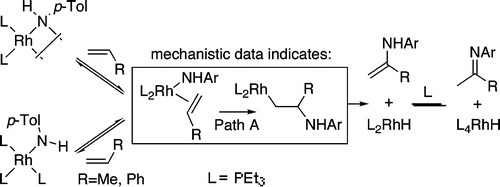Transfer of Amido Groups from Isolated Rhodium(I) Amides to Alkenes and Vinylarenes
J. Am. Chem. Soc., 2005, 127 (12066-12073)
View on publisher site
Abstract
The reaction of monomeric and dimeric rhodium(I) amido complexes with unactivated olefins to generate imines is reported. Transamination of {(PEt3)2RhN(SiMePh2)2} (1a) or its −N(SiMe3)2 analogue 1b with p-toluidine gave the dimeric [(PEt3)2Rh(μ-NHAr)]2 (Ar = p-tolyl) (2a) in 80% isolated yield. Reaction of 2a with PEt3 generated the monomeric (PEt3)3Rh(NHAr) (Ar = p-tolyl) (3a). PEt3-ligated arylamides 2a and 3a reacted with styrene to transfer the amido group to the olefin and to form the ketimine Ph(Me)C N(p-tol) (4a) in 48−95% yields. The dinuclear amido hydride (PEt3)4Rh2(μ-NHAr)(μ-H) (Ar = p-tolyl) (5a) was formed from reaction of 2a in 95% yield, and a mixture of this dimeric species and the (PEt3)nRhH complexes with n = 3 and 4 was formed from reaction of 3a in a combined 75% yield. Propene reacted with 2a to give Me2C
N(p-tol) (4a) in 48−95% yields. The dinuclear amido hydride (PEt3)4Rh2(μ-NHAr)(μ-H) (Ar = p-tolyl) (5a) was formed from reaction of 2a in 95% yield, and a mixture of this dimeric species and the (PEt3)nRhH complexes with n = 3 and 4 was formed from reaction of 3a in a combined 75% yield. Propene reacted with 2a to give Me2C N(p-tol) (4b) and 5a in 90 and 57% yields. Propene also reacted with 3a to give 4b and 5a in 65 and 94% yields. Analogues of 2a and 3a with varied electronic properties also reacted with styrene to form the corresponding imines, and moderately faster rates were observed for reactions of electron-rich arylamides. Kinetic studies of the reaction of 3a with styrene were most consistent with formation of the imine by migratory insertion of olefin into the rhodium-amide bond to generate an aminoalkyl intermediate that undergoes β-hydrogen elimination to generate a rhodium hydride and an enamine that tautomerizes to the imine.
N(p-tol) (4b) and 5a in 90 and 57% yields. Propene also reacted with 3a to give 4b and 5a in 65 and 94% yields. Analogues of 2a and 3a with varied electronic properties also reacted with styrene to form the corresponding imines, and moderately faster rates were observed for reactions of electron-rich arylamides. Kinetic studies of the reaction of 3a with styrene were most consistent with formation of the imine by migratory insertion of olefin into the rhodium-amide bond to generate an aminoalkyl intermediate that undergoes β-hydrogen elimination to generate a rhodium hydride and an enamine that tautomerizes to the imine.
Read on publisher's site
 N(p-tol) (4a) in 48−95% yields. The dinuclear amido hydride (PEt3)4Rh2(μ-NHAr)(μ-H) (Ar = p-tolyl) (5a) was formed from reaction of 2a in 95% yield, and a mixture of this dimeric species and the (PEt3)nRhH complexes with n = 3 and 4 was formed from reaction of 3a in a combined 75% yield. Propene reacted with 2a to give Me2C
N(p-tol) (4a) in 48−95% yields. The dinuclear amido hydride (PEt3)4Rh2(μ-NHAr)(μ-H) (Ar = p-tolyl) (5a) was formed from reaction of 2a in 95% yield, and a mixture of this dimeric species and the (PEt3)nRhH complexes with n = 3 and 4 was formed from reaction of 3a in a combined 75% yield. Propene reacted with 2a to give Me2C N(p-tol) (4b) and 5a in 90 and 57% yields. Propene also reacted with 3a to give 4b and 5a in 65 and 94% yields. Analogues of 2a and 3a with varied electronic properties also reacted with styrene to form the corresponding imines, and moderately faster rates were observed for reactions of electron-rich arylamides. Kinetic studies of the reaction of 3a with styrene were most consistent with formation of the imine by migratory insertion of olefin into the rhodium-amide bond to generate an aminoalkyl intermediate that undergoes β-hydrogen elimination to generate a rhodium hydride and an enamine that tautomerizes to the imine.
N(p-tol) (4b) and 5a in 90 and 57% yields. Propene also reacted with 3a to give 4b and 5a in 65 and 94% yields. Analogues of 2a and 3a with varied electronic properties also reacted with styrene to form the corresponding imines, and moderately faster rates were observed for reactions of electron-rich arylamides. Kinetic studies of the reaction of 3a with styrene were most consistent with formation of the imine by migratory insertion of olefin into the rhodium-amide bond to generate an aminoalkyl intermediate that undergoes β-hydrogen elimination to generate a rhodium hydride and an enamine that tautomerizes to the imine.